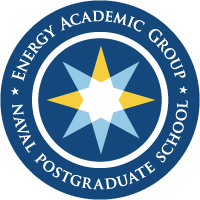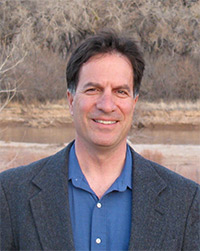July 25, 2014 - Energy Academic Group
Testing Aspects of Superdielectric Behavior
July 25, 2014
ME Lecture Hall
1300
Jon Phillips
Research Professor, Physics Department, Naval Postgraduate School
Abstract
To test a theory of the recently discovered phenomenon of superdielectric behavior, the dielectric constants of several pastes composed of porous alumina powders filled to the point of incipient wetness with water containing dissolved sodium chloride, were measured. The dielectric constants of some of the pastes were greater than 1010, which is dramatically higher than that of any material ever reported. These results are consistent with this recently postulated model of superdielectric behavior in porous, non-conductive materials saturated with ion-containing liquids. Upon the application of an electric field, ions dissolved in the saturating liquid contained in the pores will travel to the ends of pore filling liquid droplets creating giant dipoles. The fields of these giant dipoles oppose the applied field, reducing the net field created per unit of charge on the capacitor plates, effectively increasing charge/voltage ratio, hence capacitance. Other observations reported herein include, i) the impact of ion concentration on dielectric values; ii) a maximum voltage similar to that associated with the electrical breakdown of water; iii) the loss of capacitance upon drying; and iv) the recovery of capacitance upon the addition of water to a dry super dielectric material. All observations are consistent with the earlier proposed model of the super dielectric phenomenon. An extrapolation of results suggests this technology can lead to energy density greater than the best lithium ion battery.
Biography
During his time at Penn State (1981-1999) Dr. Phillips was the advisor to ten successful PhD candidates and seventeen successful MS candidates. The unifying theme of the research was materials of interest to chemical engineers, including catalysts, carbons, coal, metals. The group made contributions to the understanding of catalytic etching, bimetallic catalyst particle structure, unique catalytic chemistry of bimetallic catalysts, coal catalysis/gasification, adsorption kinetics, carbon surface chemistry, hydrogen spillover, lithium combustion, plasma interactions with materials, modification of aerosol particle structure and chemistry in plasmas, transport in plasmas, even the chemistry and structure of lubricants. The group contributed to the development of some analytical techniques including microcalorimetry, high temperature calorimetry, and Mossbauer spectroscopy. One lasting impact from this work was the invention of the Aerosol-Through-Plasma method to make catalysts. In 2009 Volvo Tech Transfer publicly expressed the belief that Dr. Phillips first patent, a means of creating supported metal catalysts using the A-T-P method, is poised to revolutionis the catalyst industry. Dr. Phillips was awarded support for two sabbaticals abroad during this time; one year as a Poste Rouge to be a staff scientist at a CNRS facility in Lyon, France (1990-91) and a Fulbright Fellowship to work as a faculty member at Ben Gurion University in Beersheva, Israel (1997-98).
From 1999 until 2011 Dr. Phillips served as a staff scientist at Los Alamos National Lab, and as a National Lab Professor at the University of New Mexico. During that time he was the advisor to nine postdoctoral fellows. A major focus of the work was plasma/materials interactions. One result: patents for making a variety of structures using plasmas including carbon nanotubes, nanometal and nanooxide particles and engineered multi-layer nanoparticles for use in batteries. Another major focus was developing a mechanistic model of the growth of carbon structures in combustion environments. Scientifically this led to the development of a theory that the building blocks of solid carbon growth in combustion environments are homogeneously created radicals. Technologies that resulted include novel carbon fiber foams of controlled shape and microstructure. Other thrusts at LANL included studies of the corrosion of lithium, development of novel nuclear fuel structures, and fundamental plasma studies.
In April of 2011 Dr. Phillips accepted his current position as Research Professor at the Naval Post-Graduate School (NPS). In that position Dr. Phillips teaches courses, primarily thermodynamics, and directed the thesis work of four MS students. His chief research interest is developing uses for reduction-expansion synthesis. Thus far the work has led to publications/patents for making sub-micron metal particles from metal nitrates, metal oxides and metal hydroxides, and graphene. Preliminary studies suggest the method can be employed to make paradigm shifting supported metal catalysts. Dr. Phillips is also pursuing the development of unique high dielectric constant material at NPS, will soon publish an article revealing the invention of super dielectrics, that is materials with dielectric constants more than six orders of magnitude greater than the present best material, barium titanate.
Dr. Phillips has published more than 130 widely cited (>2400 citations, h factor 23) reviewed journal articles. He holds nineteen issued patents, seven now licensed, most of which involve novel materials or processes for making materials using a process he named Aerosol-Through-Plasma (A-T-P). He has more than twenty pending patents. From 2010 -2013 Dr. Phillips held more licensed patents than any other LANL employee. Recognitions include a Fulbright Fellowship for study in Israel 1997-1998, Poste-Rouge support for a year at a CNRS research institute in France in 1991. He headed a team that was awarded an R&D 100 award in 2004 for the invention “Plasma Torch Production of Spherical Boron Nitride� and headed another team that was awarded a Nano 50 award in 2005 for the invention “Graphitic Structures by Design.
POC
Dr. Daniel A. Nussbaum
Naval Postgraduate School
Principal, Energy Academic Group
Monterey CA 93943
Phone: 831-656-2387
Mobile: 831-324-3228
Email: dnussbaum@nps.edu


